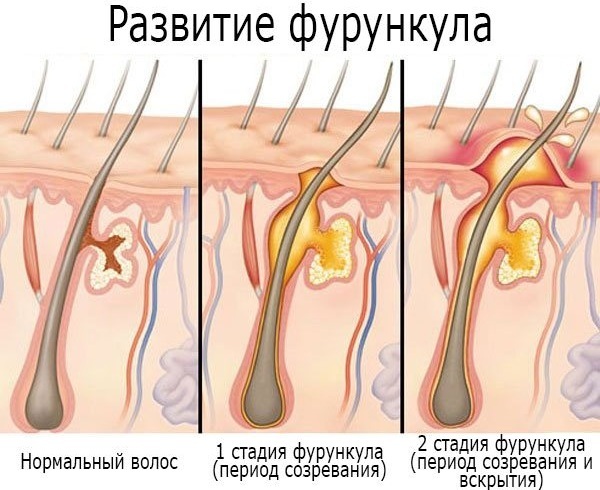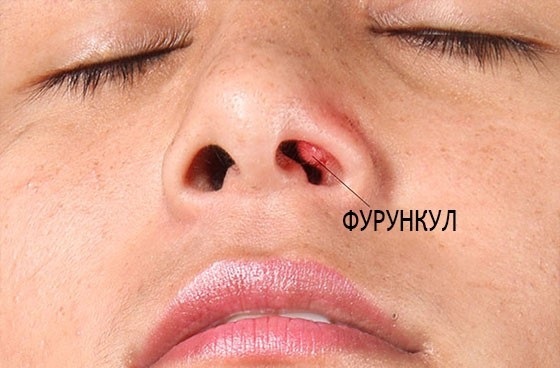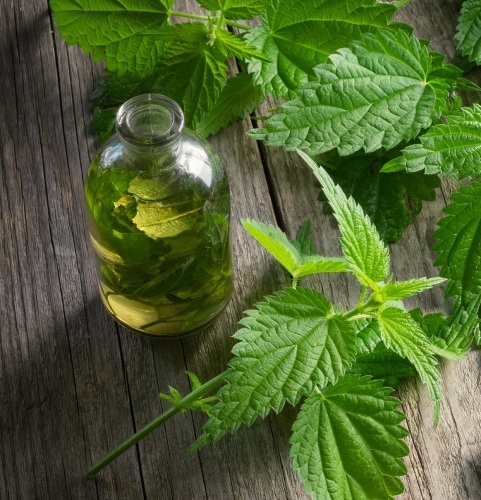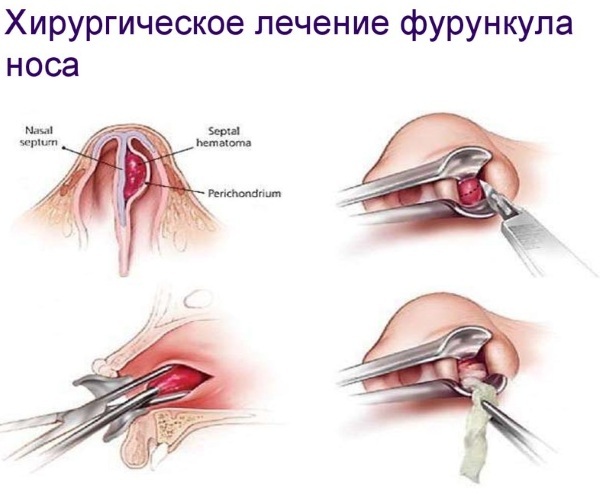Boil, abscess, or boil refers to inflammation in the hair follicle or sebaceous gland. Adjacent tissues are additionally affected. The disease has a purulent-necrotic character.
The boil can be localized throughout the body, the nasal cavity is not excluded. Most often, a boil is formed on the wings of an organ, in the area of the vestibule and the bridge of the nose. A boil can be characterized by consequences, so it is necessary to know how to treat education.
Record content:
- 1 Reasons for the appearance and psychosomatics
- 2 How does the furuncle of the nose develop, how dangerous is it?
- 3 Which doctor should I go to?
- 4 Can I squeeze out a boil myself?
- 5 Treatment of a boil at an early stage
-
6 Drug treatment
- 6.1 Local remedies
- 6.2 General therapy means
- 7 Treatment with folk remedies
- 8 Possible complications and consequences
- 9 Video about a boil in the nose
Reasons for the appearance and psychosomatics
A boil in the nose (can be treated with antibiotics) is a painful pustule (a blister filled with pus) with necrosis in the center (the core of the formation). Boil occurs in 45% of all pyoderma (pyoinflammatory diseases).
Boils in the nose are formed in all age groups. But most often they are found at 15 - 45 years old. In men, abscesses appear 1.5 - 1.7 times more than in women.
A furuncle in the nose is associated with the influence of aureus, epidermal, saprophytic staphylococcus or hemolytic streptococcus (rarely). These are opportunistic bacteria that can harm the body only under certain circumstances. For example, staphylococcus and streptococcus multiply with a decrease in immunity.
There are risk factors that increase the likelihood of a boil.
Namely:
- Damage to the skin. The likelihood of infection increases with the appearance of a cut, abrasion and other violations of the integrity of the cover. And also this item includes surgical interventions - rhinoplasty (correction of nose deformities), installation of implants. Additionally, skin damage is possible when removing nose hair with forceps.
- Runny nose. The integrity of the skin is compromised if you rub the cover with paper napkins.
-
The presence of other purulent pathologies.

How to treat a boil in the nose depends on the cause - Diseases. The infection can come from other organs. The item includes sinusitis (inflammation in the maxillary sinuses), tonsillitis (acute lesion of the lymphatic pharyngeal ring), dental caries.
- Reduced immune defenses. This may be due to frequent hypothermia, stressful situations, climate change. Immunity is affected by overwork, lack of vitamins or trace elements, prolonged and uncontrolled use of drugs (for example, corticosteroids). Additionally, the likelihood of the appearance of a boil increases with an unbalanced diet, excessive physical exertion. And also immunity decreases in various diseases - malignant tumor, HIV, diabetes mellitus. Additionally, it is possible to weaken the protection during the course of chemotherapy, anemia (reduced amount of hemoglobin and erythrocytes).
- Failure to comply with the rules of personal hygiene. If a person rarely washes the body, the skin becomes greasy, and the number of pathogenic microorganisms increases. In addition to the item, there is an untimely cleaning of the house, the use of other people's personal hygiene items (razor, towel). And also a boil can occur if a person touches his face with dirty hands.
- Working conditions. Inhalation of dusty air or constant contact with fuels and lubricants.
- Increased sweating. Excess sebum is an ideal breeding ground for pathogens.
In psychosomatics, there is an opinion that the formation of a boil is associated with the achievement of a peak of negative emotions. That is, anxiety, fear, anger come out in an unnatural way (an abscess).
How does the furuncle of the nose develop, how dangerous is it?
Boil in the nose (can be treated with topical agents) has a classification.
The boil is subdivided into the following stages:
- Initial. The skin around the nose turns red, the borders do not have a clear shape. Additionally, there is soreness in the place where the boil appears. The discomfort is aggravated by palpation of the skin. Also, edema is noticeable, which can spread to adjacent tissues - cheeks, lips.
- Infiltration. It is characterized by gradual (within 1 - 2 days) formation of a cone-like seal. In the center of education, you can see a dark point - this is an area of tissue necrosis (death).
Additionally, there is pain that is aching (in any position of the body) and sharp (when pressing on the boil) character. And edema also increases. The duration of this stage is from 1 to 3 days.
- Abscess formation. This stage occurs 3 to 7 days after the onset of symptoms. The center of education becomes soft, the density of the tissue at the site of the lesion decreases. Above the boil, you can see the rod, which has a yellow-white color. For 2 - 3 days, it forms into an abscess. During maturation, severe pain is noted, tension in the soft tissues of the nose. Discomfort intensifies when talking, chewing food, feeling a boil. The pain does not decrease even at night, the person cannot fully sleep. Intoxication (a condition that occurs under the influence of toxic substances) is not excluded, the signs of which are weakness and malaise, an increase in body temperature up to 39 degrees.
- Permissions. The boil is opened independently or with the help of a surgeon. The rod breaks through, this is accompanied by the release of exudate (liquid). Additionally, a person's well-being improves, temperature and pain decrease. After emptying the boil cavity, it fills with new connective tissue and heals. In the first 3 - 4 days, a retracted scar remains on the skin, then it becomes less noticeable.
 The main danger of a boil is the possibility of a deep necrotic rod. There is a chance that the inflammation will develop into nearby tissues that surround the boil. Additionally, the boil is located on the face, that is, inflammation of the brain, loss of hearing and vision cannot be ruled out. And also after a boil, scars and bumps may remain on the face.
The main danger of a boil is the possibility of a deep necrotic rod. There is a chance that the inflammation will develop into nearby tissues that surround the boil. Additionally, the boil is located on the face, that is, inflammation of the brain, loss of hearing and vision cannot be ruled out. And also after a boil, scars and bumps may remain on the face.
In addition, some do not attach much importance to the boil, they open it on their own, and they do not always remove pus. As a result, there is a possibility of blood poisoning, the spread of pus into the surrounding tissues, and the transition of the boil into a chronic form.
Which doctor should I go to?
A boil in the nose is a formation, at the appearance of which it is necessary to visit a doctor. Diagnosis of a boil is in the competence of an otolaryngologist (ENT). The specialist conducts a survey and prescribes the current treatment.
When collecting an anamnesis, the doctor takes into account the reasons that could cause a boil, as well as concomitant pathologies. Additionally, it is necessary to tell the otolaryngologist about all the symptoms that bother a person.
To clarify the diagnosis, the following methods may be prescribed:
- examination of the nasal cavity (rhinoscopy);
- complete blood count (CBC) - allows you to identify inflammation;
- sowing for streptococcus and staphylococcus;
- x-ray of the facial skeleton;
- magnetic resonance imaging (MRI) or computed tomography (CT) of the face - procedures are performed with a low diagnostic value of the X-ray.
An urgent need to visit a doctor if one of the following signs is present:
- the boil core does not form within 3 to 4 days from the moment the first symptoms appear;
- education causes severe pain;
- a lot of pus has accumulated under the skin;
- a person's well-being worsens;
- body temperature has risen sharply;
- in a few days no changes in the boil occur;
- the boil reappeared.
Can I squeeze out a boil myself?
Doctors have a negative attitude to squeezing the boil.
If the procedure is carried out incorrectly, the following consequences are possible:
- increased inflammation and swelling;
- the spread of pathological bacteria to other parts of the body;
- pus in the eyes or on a healthy area of the skin.
Treatment of a boil at an early stage
Most often, a boil is treated with conservative methods. Prescribe the use of drugs and folk recipes. Surgery is performed when there is a high likelihood of complications or ineffectiveness of conservative therapy.
The method of treatment is selected by a specialist, taking into account the stage of the boil, concomitant diseases, and characteristics of the body.
Drug treatment
Medicines can make a person feel better, eliminate negative symptoms, and speed up recovery.
Drug treatment is divided into the following types:
- local therapy - is the treatment of the skin with ointments, solutions and other forms of release;
- general therapy - involves taking medications inside.
Local remedies
In the presence of a boil, it is necessary to use topical preparations.
External remedies in the form of an ointment, gel or cream:
- Baneocin.
- Levomekol.

Levomycetin (Levomekol) eye ointment - Levosin.
- Ichthyol ointment.
- Vishnevsky ointment.
- Synthomycin ointment.
- Bepanten.
- Celestoderm.
- Triderm.
- Traumeel S.
- Oflomelide.
- Sulfuric ointment.
- Solcoseryl.
- Tetracycline.
Additionally, it is recommended to use antiseptic agents.
Popular drugs:
- Miramistin.
- Chlorhexidine.
- Chlorophyllipt.
- Betadine.
- Iodine.
- Brilliant green.
- Fukortsin.
General therapy means
Boil in the nose provides for the use of general therapy. Their list is shown in the table.
| Group of drugs | Effect of application | List of funds |
| Antibacterial | Fight against pathogenic microorganisms. | In the presence of a boil, the following medications can be used:
|
| Non-steroidal anti-inflammatory drugs (NSAIDs) | Reduces pain, inflammation, temperature. | NSAIDs include the following drugs:
|
| Antihistamines | Eliminate skin redness and swelling. | Antihistamines include the following:
|
| Anticoagulants | Prevents the formation of blood clots. Taking these drugs allows you to avoid complications (thrombosis, thrombophlebitis). | Anticoagulants include the following drugs:
|
| Sedatives | Normalize the emotional background of a person. | Novo-Passit, Persen, Tenoten |
| Immunostimulants | Stimulates immune defenses. | Immunal, Echinacea-P, Stimmunal |
| Vitamin complexes | Replenish the lack of vitamins and minerals. | Complivit, Supradin, Vitrum Plus |
Treatment with folk remedies
A boil in the nose (it can be treated with NSAIDs) is a formation in which the use of folk recipes is allowed. They have a vegetable composition, so the likelihood of side effects is low. Folk remedies accelerate the ripening of the boil and draw out pus. The doctor may recommend a comprehensive treatment, that is, a combination of medications with prescriptions.
When a boil appears, the following folk methods are effective:
-
Aloe juice. The plant eliminates inflammation, accelerates wound healing, and kills germs.
 To eliminate the boil, you can apply a compress.
To eliminate the boil, you can apply a compress.
- You should take 1 leaf of aloe and cut it into 2 pieces (lengthwise).
- Attach the plant to the boil (cut side).
- You can secure the aloe with a plaster or bandage.
- Keep the compress for 30-40 minutes, apply 3-4 times a day.
- To enhance the effectiveness, you can leave the compress overnight.
If the abscess is large and protrudes strongly above the skin, the aloe must be crushed. And you can also squeeze out the juice of the plant and apply it to a sterile gauze napkin, attach it to the boil.
- Honey. The component has anti-inflammatory, warming, disinfecting effect. Additionally, honey accelerates the maturation of the boil, reduces swelling and soreness. The component is applied in the form of a compress.
- To prepare it, you must mix the same amount of natural liquid honey and flour (wheat or rye).
- Next, form a cake, attach to the boil, fix with a bandage.
- The compress should be changed 2 - 3 times a day.
- The recipe should be applied until the boil is ripe.
- Garlic. The product destroys pathogenic microorganisms. For boils, a garlic compress is used.
- To prepare it, you need to finely chop or grate the product.
- To reduce the likelihood of skin burns during use, garlic should be mixed with raw potatoes, laundry soap or baked onions in equal proportions.
- The compress should be applied to the abscess every day, kept for 2 - 3 hours. Overnight prescription is allowed.
- Stop using when opening the boil.
The recipe is not suitable for people with sensitive skin.
- Calendula. Another name for the plant is marigold. The component has anti-inflammatory, analgesic, antibacterial action. In the presence of a boil, calendula ointment is applied.
- For its preparation, you should take 1 tsp. l. dry crushed flowers of the plant and 1 tbsp. l. petroleum jelly.
- Mix everything thoroughly, leave for 8 - 12 hours.
- Apply the ointment to a sterile gauze pad, attach to the boil and secure with a plaster.
- The compress should be replaced daily with a new one.
-
Herbal tincture. The tool is used as a disinfection of the boil surface.

- To prepare the recipe, you must mix 1 tbsp. l. dried and chopped nettle root, 0.5 tbsp. l. garlic (pre-chopped).
- Add 500 ml of boiled water to the mass.
- Close the jar with a lid, leave for 7 days in a dark place.
- After preparing the product, lubricate the boil 2 to 3 times a day.
- The mixture can be stored in the refrigerator.
- Laundry soap. The recipe has antiseptic properties.
- For cooking, you will need laundry soap, which should be chopped with a knife and placed in a water bath.
- After softening the component, add milk to the container (2 times more soap).
- Cook the composition to the consistency of sour cream, wait until it cools.
- Apply the mixture to the bandage, attach to the boil, secure with a plaster.
- It is important to change the compress daily. The recipe is used before the pus leaves the formation.
- Blue clay. The product cleanses the skin of toxins, stimulates metabolic processes, draws pus from the boil.
- For cooking, you need to take 3 tbsp. l. blue clay, 1 tbsp. l. apple cider vinegar.
- Mix the ingredients thoroughly, add water to thicken the consistency.
- Apply the mixture to the boil, fix a sterile gauze napkin on top. It is necessary to change the compress 2 times a day.
Possible complications and consequences
The prognosis is favorable if the boil is detected and cured in a timely manner. Most often, complications occur when a person does not go to a doctor or squeezes out a boil on his own.
The boil is characterized by the consequences:
- Diseases of the eyes. This list includes blindness, inflammation of the orbit, and misalignment of the eyeball (bulging).
- Thrombophlebitis of the facial veins - inflammation of the vein wall and the formation of a blood clot.
- Thrombosis of the intracranial venous system. Complication involves the formation of blood clots in the veins of the brain and nearby vessels. As a result, ischemia (lack of oxygen) develops.
- Inflammation of the brain. For example, meningitis.
- Sepsis is a purulent-septic disease, implying blood damage. The infection spreads throughout the body, is difficult, threatens human life.
- Sinus affection. The item includes frontal sinusitis (inflammation of the mucous membrane in the area of the frontal sinuses), sinusitis (the process affects the maxillary sinuses).
- Death. May be associated with meningitis, sepsis.

A boil is an inflammation in a hair follicle or sebaceous gland. An abscess can be localized in various places, but the most dangerous is the face. A boil in the nose is characterized by redness, soreness, and swelling of the skin. When a boil appears, you should consult an otolaryngologist. The specialist will conduct a survey and examination, if necessary, send the patient for diagnosis.
Further, treatment is prescribed, which includes the use of drugs and folk remedies. A boil can be characterized by consequences (meningitis, sepsis, and more). To reduce the likelihood of complications, you must follow the doctor's recommendations.
Video about a boil in the nose
How to treat a boil in the nose:



